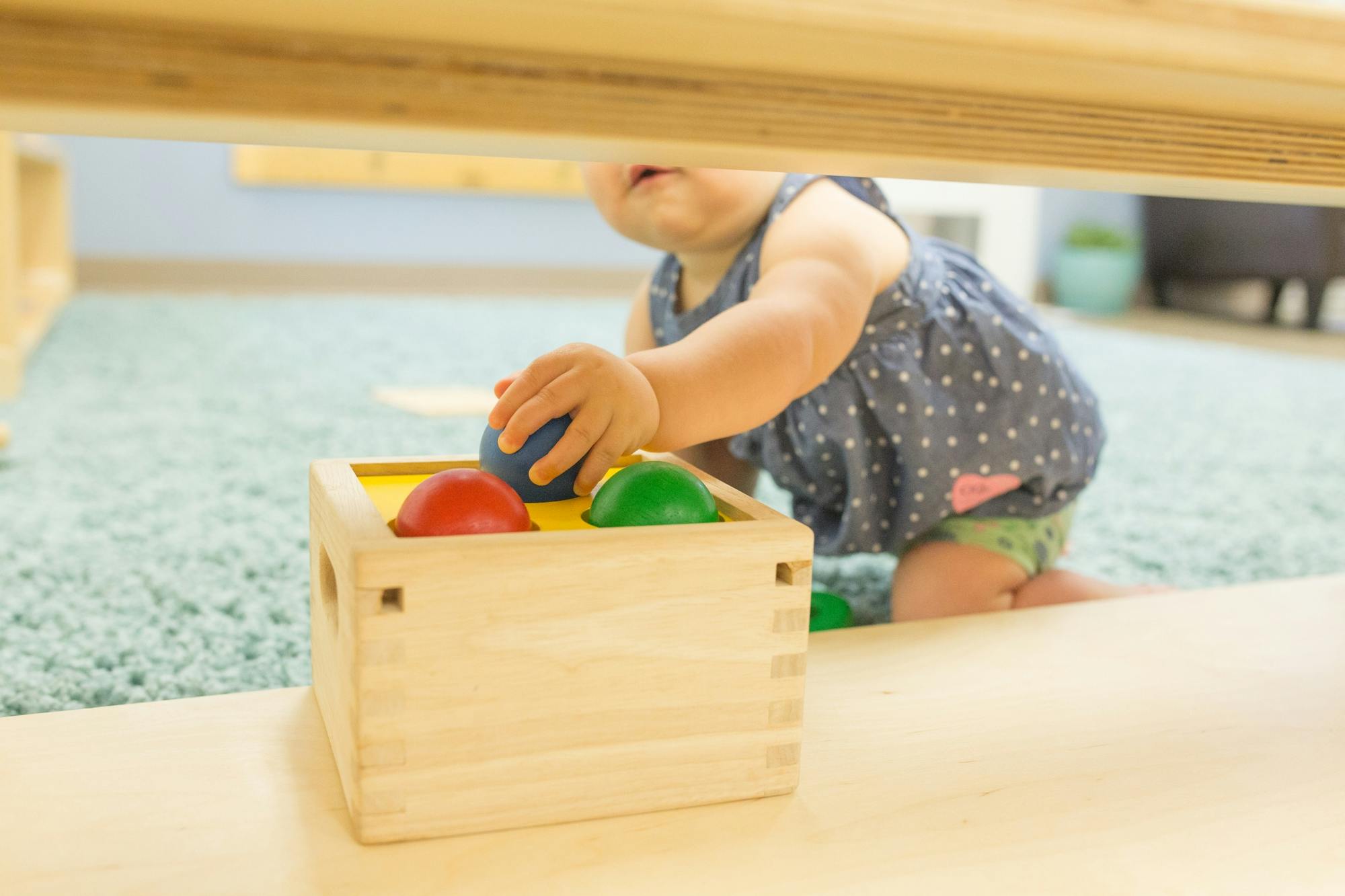A child’s early mathematical ability comes from an exploration of the world with all five senses. Those early experiences, in the first weeks and months of life, are preparations that lead to later success.
For example, newborns discover that their cries lead to an adult reaction. If we can consistently address the child, and satisfy their needs, this is the Mathematical Mind’s first lesson on cause and effect.
As Maria Montessori described it in The Absorbent Mind, the Mathematical Mind is the human capacity that helps each of us recognize patterns, categorize experiences, and understand the surrounding world. The child under three uses her senses to unconsciously absorb everything that happens to her. Then, the Mathematical Mind categorizes those experiences.
That’s why it’s important to give infants experiences to categorize by putting them in touch with their environment. They need time to explore on a mat on the floor. Place interesting, safe, objects nearby, but just out of reach. They are grasping with their fingers, but also with their minds, making sense of the wondrous world around them.
Tummy and floor time allows them to learn about how their body moves and relates to the environment while also helping to build intelligence. Through experimentation, they discover gravity and physics. Babies love the game of dropping objects and waiting for someone else to pick it up.
Two-dimensional educational experiences are no substitute for what a child will discover through hands-on play.
Language and the Mathematical Mind
At around 9-10 months, babies discover that words have meaning, allowing them to categorize human speech into an understood language. We typically don’t think we need to “teach” a baby to talk. If we provide an immersive language environment, it happens effortlessly.
The same is true for mathematics. Sensorial experiences and spoken language provide the framework for the Mathematical Mind to do its work. When interacting with babies and toddlers, incorporate words that reflect the concepts of mathematics. You can narrate the child’s activity (if doing so doesn’t break their concentration).
Encourage them with phrases like:
- “Try it again,” or “Take your time.”
- “Yes, the cube fits into the square,” or “Twist the piece until it fits,” or “You have too many, take some out.”
Use questions to inspire exploration:
- “Which comes next?” or “Are they the same size?”
Incorporate mathematical vocabulary like: ‘increases,’ ‘less than/greater than’ ‘enough,’ ‘now,’ ‘later,’ ‘sharing,’ ‘equal,’ and so on.
Have conversations involving numbers, counting and arithmetic with and around your children.
- When you are at the grocery store, discuss how much food you are buying and why. “This many ounces of rice will feed our family of six for one week.”
- Model telling time, counting money or other objects, measuring, and calculating.
- Do math in front of your children, using paper and pencil instead of a device to calculate, or talk through the process of doing a math problem in your head.
When the child is older and is introduced to formal math presentations, they will have seen math’s practical application in their own life, done by people they love.
Food preparation, practical life activities, and any opportunity to match, sort, or build, support the categorization done by the Mathematical Mind. To successfully chop a cucumber or build a tower, the child must coordinate their movements to achieve the goal.
Incorporate Daily Life Into the Discovery of Math
Through the activities of daily life, children discover that the world is full of tools, such as a toothbrush, a cup, or a hand towel. Math is a tool, too. This foundation is important because it means the child understands that the tools they need are out there — they just need to find the right one for the task. The spoon is a better tool for eating soup than a knife. Similarly, with mathematical concepts, they might later ask, “Do I need statistics or algebra?”
Around 18-months, they also begin to understand one-to-one correspondence between concrete things. For example: “There is one sock and one foot; two sleeves and two arms.” Very young children can set the table. They can say, “One, two, three forks for one, two, three people.”
They can recognize numbers, and even count by memory, but in general, children do not fully understand the connection between symbol and quantity until three or four years old. Around this time, a child could see the numeral 8 and accurately count eight objects.
Connecting symbol and quantity is a developmental achievement that takes time to acquire. For children under age three, we can support this development by providing opportunities for exploration, using mathematical language, and involving them in the activities of daily life. Each and every experience is categorized by the Mathematical Mind and creates the early building blocks that add up to math proficiency later in childhood.
Blog written by Montessori Mentor, Emily Daggett. Special thanks to Mariana Bissonnette and Nadxieli Toledo Bustamante for their wisdom related to this topic.
